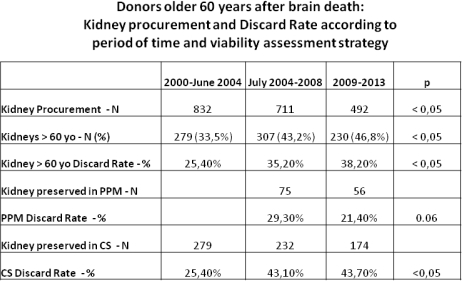Is the Pulsatile Kidney Preservation Machine a Vaulable Tool in Evaluating Kidney Suitability from Older Donors After Brain Death?
1Donation and Transplant Coordination Section, Hospital Clinic, University of Barcelona, Barcelona, Spain
2Urology Department, Hospital Clinic, University of Barcelona, Barcelona, Spain
3Renal Transplant Unit, Hospital Clinic, Barcelona, Spain.
Meeting: 2015 American Transplant Congress
Abstract number: B79
Keywords: Graft acceptance, Kidney transplantation, Machine preservation, Renal injury
Session Information
Session Name: Poster Session B: Ischemia/Reperfusion Injury: Strategies To Minimize Ischemia Reperfusion Injury
Session Type: Poster Session
Date: Sunday, May 3, 2015
Session Time: 5:30pm-6:30pm
 Presentation Time: 5:30pm-6:30pm
Presentation Time: 5:30pm-6:30pm
Location: Exhibit Hall E
Introduction: Donors after Brain Death (DBD) older than 60 years old, have become 46.8% of our donor activity, with higher Discard Rate (DR). Assessment of kidney suitability requires a protocol of complimentary tools to decide organ suitability: macroscopic evaluation, Kidney Biopsy Score (KBS) and renal hemodynamic evaluation with Pulsatile Perfusion Machine (PPM).
Methodology: Analysis of a descriptive, cross-sectional, comparative study of kidneys procured and DR, comparing three time periods: 2000-June 2004 when only KBS were used; July 2004-2008 (introduction of PPM) and 2009-2013 (experienced use and acceptance of PPM). Accepted transplantation criteria were KBS<3 and PPM Renal Resistance (RR) <0.4 mmHg/ml/min and arterial Renal Flow (RF) >70ml/min.
Results: The table  showed a 59.2% reduction in DBD procured kidneys as well as a reduction in the procured older kidneys. However, the relative proportion of older kidneys has increased from 33.5% to 46.8%. The DR has increased comparing first to third period from 25.4% to 38.3%. However, the DR was lower when kidneys were evaluated with PPM than those evaluated only with KBS and preserved in CS (21.4% vs 43.7%). No differences were founded between both preservation groups, regarding age, gender, CVRF and cause of death. Only significant difference was found in cold ischemia time, because CS kidney was grafted before PPM kidneys. During third period, more kidneys with KBS equal or >4 were assigned to PPM.
showed a 59.2% reduction in DBD procured kidneys as well as a reduction in the procured older kidneys. However, the relative proportion of older kidneys has increased from 33.5% to 46.8%. The DR has increased comparing first to third period from 25.4% to 38.3%. However, the DR was lower when kidneys were evaluated with PPM than those evaluated only with KBS and preserved in CS (21.4% vs 43.7%). No differences were founded between both preservation groups, regarding age, gender, CVRF and cause of death. Only significant difference was found in cold ischemia time, because CS kidney was grafted before PPM kidneys. During third period, more kidneys with KBS equal or >4 were assigned to PPM.
Conclusions: Nevertheless the decrease in older DBD procured kidneys during last period, the use of PPM has allowed low DR compared with CS. A bias in the results of PPM could be generated when kidneys with higher KBS are excluded from PPM. The only use of KBS to decide acceptance, could preclude to offer the kidney an additional tool to evaluate suitability.
To cite this abstract in AMA style:
Zapata DParedes, Arranz ARuiz, Villar CRodriguez, Cussi LPeri, Asensio AAlcaraz, Bartolome RAdalia, Salinas FOppenheimer. Is the Pulsatile Kidney Preservation Machine a Vaulable Tool in Evaluating Kidney Suitability from Older Donors After Brain Death? [abstract]. Am J Transplant. 2015; 15 (suppl 3). https://atcmeetingabstracts.com/abstract/is-the-pulsatile-kidney-preservation-machine-a-vaulable-tool-in-evaluating-kidney-suitability-from-older-donors-after-brain-death/. Accessed December 15, 2025.« Back to 2015 American Transplant Congress
